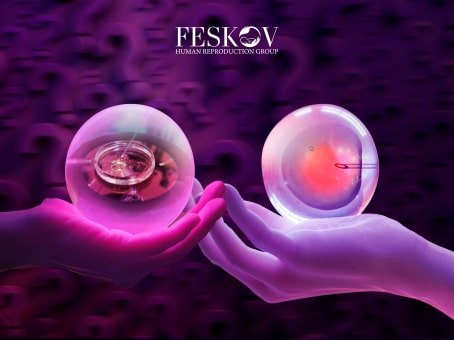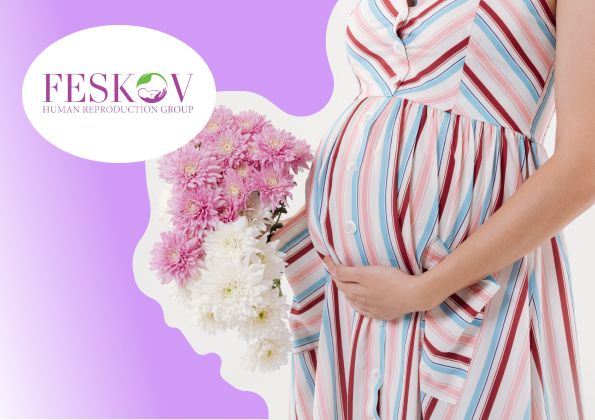
What Is The Difference Between IVF And ICSI?

Future parents entering a reproductive program always have more questions than answers.
- About IVF and ICSI
- Types of IVF
- IVF success vs. ICSI
- Side effects of IVF and ICSI
- Cost of IVF vs ICSI
- Additional techniques
- What to do with unused embryos?
Many special terms, names of medications and procedures enter their lives. To make it easier for you to stay in the same context with your attending physician, Feskov Human Reproduction Group has created a blog with answers to the most popular questions of expectant parents. We hope the information will help expectant parents feel more confident and better understand what to expect.
In this article we will answer the question “IVF and ICSI: what is the difference?” Let’s figure out what these methods are, how they are related to each other, and what they bring to future parents. In addition to the article, we recommend that you read reviews from our clients, confirming the effectiveness of our methods.
About IVF and ICSI

What is IVF and ICSI? Let's start with definitions of terms. IVF is a method of treating infertility, in which an embryo created in the laboratory (the oocytes are simply mixed with sperm in a special environment, and fertilization occurs randomly) is transferred into the uterus of a woman (in particular, a surrogate mother). ICSI is not an independent technique, it is part of the IVF procedure. In IVF with ICSI, the embryologist delivers the sperm to the egg using a microsurgical instrument.
That is, the main difference between ICSI and IVF is the degree of participation of the embryologist in the process of creating an embryo: if the sperm, due to some factors, cannot fertilize the oocyte, the process of creating the embryo is completed by the embryologist.
Some indications for the use of IVF with ICSI:
- severe disorders of spermatogenesis;
- ejaculatory dysfunction;
- failures in the previous reproductive program: absence or low percentage of fertilization (less than 20%) of eggs;
- small number of eggs (less than 4).
IVF with ICSI are also justified in the case of using cryopreserved oocytes and sperm. In world practice, in principle, there is a tendency to use ICSI as a factor in increasing the likelihood of creating an embryo.
Types of IVF
There are several types of IVF that can be performed with or without ICSI:
- long protocol;
- short protocol;
- Japanese protocol;
- IVF in a natural cycle.
The goal of the long protocol is to obtain the maximum number of oocytes of good quality. The menstrual cycle and egg maturation occur under the influence of hormonal drugs, which allow the attending physician to control the process. This approach also allows you to increase the endometrium to optimal thickness to increase the likelihood of pregnancy. The risk of this method is the increased likelihood of ovarian hyperstimulation.
If there is an increased risk of overstimulation or failure of long protocols, a short protocol is prescribed. With this approach, the woman’s body is exposed to less exposure to hormonal drugs. However, there is also a negative side: fewer oocytes are obtained than in the long protocol.
The Japanese protocol involves minimal stimulation of the ovaries with low doses of hormones. Most often, oocytes obtained in this way are cryopreserved and used in the next cycle.
IVF in a natural cycle is used when there are significant contraindications to hormonal stimulation. The egg matures naturally without taking drugs. The difficulty lies in determining the moment of ovulation, which requires high medical skill.
Types of IVF are selected by the attending physician taking into account the individual characteristics of the woman and a thorough study of her medical history.
It does not matter whether IVF ICSI or classic IVF is carried out, the process is as follows:
- Hormonal stimulation (or waiting for the natural maturation of the oocyte).
- Retrieval of eggs through follicle puncture (under local anesthesia).
- Creation of an embryo (as a result of spontaneous fertilization in a nutrient medium or due to the delivery of sperm to the egg using ICSI).
- Cultivation of embryos (storage in the laboratory for 2-5 days).
- Transfer of an embryo into the uterus (IVF).
If several embryos of good quality are obtained, they can be frozen for subsequent programs.
Once you have learned what ICSI and IVF are, you will probably be interested in learning about the success rate of these approaches.
IVF success vs. ICSI
According to the latest studies of the impact of ICSI with IVF on the success of reproductive programs, a lack of patterns has been revealed. That is, IVF ICSI does not increase the likelihood of pregnancy and the birth of a child, but only helps to obtain an embryo for those couples who suffer from male factor infertility (spermatogenesis disorders, low sperm motility, ejaculatory dysfunction, etc.).
Side effects of IVF and ICSI
Like any medical procedure, ICSI and IVF may have side effects. The most typical:
- ovarian hyperstimulation syndrome;
- multiple pregnancy;
- premature birth;
- low birth weight of the newborn.
As in all other cases, the recommendation for future parents interested in the ICSI IVF procedure is standard: trust your doctor, follow his recommendations and discuss any questions and concerns with him.
Cost of IVF vs ICSI
In general, the price difference between classic IVF and ICSI is insignificant. Therefore, the likelihood of offering an additional ICSI technique to IVF in order to increase the cost of clinic services is not justified. If you were offered this approach, it was for the sole purpose of maximizing the likelihood of creating a high-quality embryo. Many clinics by default resort to IVF ICSI in reproductive surrogacy programs with egg donation.
Additional techniques

Additional methods supposedly capable of increasing the effectiveness of ICSI IVF may be endometrial scratching - applying light scratches in order to provoke an influx of immune cells and increase the endometrium's receptivity to the embryo, and prescribing hormonal drugs.
You should know that endometrial scratching is not a fully researched technique that does not have a convincing evidence base to talk about its effectiveness.
As for hormone prescriptions, this is the responsibility of your personal physician. Considering the risks of using hormonal drugs, they are prescribed when indicated. And it's also a matter of trust in your communication with your doctor.
What to do with unused embryos?
In some cases, a reproductive program can create several good quality embryos that will not be used for transfer. Cryo-frozen embryos will be stored in a cryobank for several years. At the end of the storage period, you will have to decide their future fate.
You have 4 ways:
- Submitting an application to extend the shelf life (especially justified if you are planning to have one or more children).
- Embryo disposal.
- Permission to use embryos in scientific research.
- Donating embryos to people who need them.
If you find it difficult to make a decision on your own, you can always discuss this issue with your clinic.
We are thrilled to be able to provide you with reliable information to help you on your reproductive journey. If you have any other questions, ask them to the manager in the chat and get a free consultation with a doctor at our clinic.
- Surrogate motherhood - how not to be deceived
- The cost of parenthood: an overview of reproductive programs from leading clinics
- Advantages of guaranteed surrogacy programs over programs with guaranteed compensation
- Disadvantages of Egg Donation - Only Truth about the Procedure
- Unique Cases of Giving Birth to Children
- Donor egg + IVF: cost, guarantees, pitfalls
- How the History of Surrogacy Changed Over the Years
- Why I Chose Surrogate Motherhood with Feskov
- The First Meeting: 5 Helpful Tips for Surrogates & Intended Parents
- Pregnancy After Miscarriage: Getting Pregnant
- Surrogacy in Ukraine: Legal Aspects
- Women's Age And Fertility
- Alcohol And Fertility: Drinking While Trying To Conceive
- Let's date you in Paris!
- Historical Changes to Surrogate Laws in Israel
- Egg donor in Europe
- TOP 5 surrogate clinics in Ukraine
- International Surrogacy Program Ukraine-Canada
- Why is surrogacy so expensive — what do you pay for
- 15 facts about Surrogacy
Join my mailing list to receive the latest news and updates
What is IVF, and how does it differ from ICSI?
read moreIVF is a method of treating infertility that involves creating an embryo in a laboratory and transferring it to a woman’s uterus. ICSI is part of the IVF process that allows the creation of an embryo through the controlled insertion of a sperm into an egg.How does the fertilization process occur in traditional IVF?
read moreWith traditional IVF, eggs and sperm are simply placed in a special environment where fertilization should occur spontaneously, without the participation of an embryologist.What is ICSI, and how does it work in assisted reproduction?
read moreICSI is a medical procedure in which an embryologist uses a thin needle to deliver sperm directly into the egg. After creating an embryo in this way, the further process is no different from classic IVF.In what situations is ICSI recommended over traditional IVF?
read moreICSI technique is prescribed mainly for male factor infertility. This approach allows you to create an embryo in cases of low sperm motility, ejaculatory dysfunction, severe disorders of spermatogenesis, etc.
